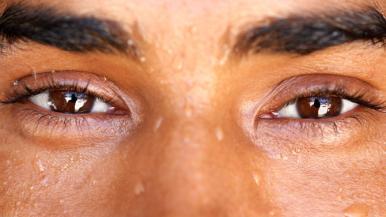A close look at the complex systems that keep us functioning can inspire awe. Such is the case with the body's complicated temperature-regulating mechanism.
This intricate apparatus balances heat production with heat loss, keeping the body at a temperature just right for optimal function. This balancing act is directed automatically and seamlessly by the hypothalamus, a small portion of the brain that serves as the command center for numerous bodily functions, including the coordination of the autonomic nervous system.
Much like a thermostat regulates the temperature inside your home, the hypothalamus regulates your body temperature, responding to internal and external stimuli and making adjustments to keep the body within one or two degrees of 98.6 degrees.
Systematized
But unlike a thermostat, which simply turns the heat or air conditioning on or off until a desired temperature is reached, the hypothalamus must regulate and fine-tune a complex set of temperature-control activities. It not only helps to balance body fluids and maintain salt concentrations, it also controls the release of chemicals and hormones related to temperature.
The hypothalamus works with other parts of the body's temperature-regulating system, such as the skin, sweat glands and blood vessels — the vents, condensers and heat ducts of your body's heating and cooling system.
The middle layer of the skin, or dermis, stores most of the body's water. When heat activates sweat glands, these glands bring that water, along with the body's salt, to the surface of the skin as sweat. Once on the surface, the water evaporates. Water evaporating from the skin cools the body, keeping its temperature in a healthy range.
Sensitive
In a related function, blood vessels react to the introduction of outside organisms, such as bacteria, and to internal hormone and chemical changes by expanding and contracting. These actions move blood and heat closer to or farther from the skin, thus releasing or conserving warmth.
When all parts of the body's heat-regulating mechanism operate smoothly, body temperature stays near 98.6 degrees. However, there are times when body temperature can go awry.
Heatstroke | Hot flashes | Fever
Heatstroke
On most days, the hypothalamus reacts to increases in outdoor temperature by sending messages to the blood vessels, telling them to dilate. This sends warm blood, fluids and salts to the skin, setting off the process of evaporation.
Problems occur when a person is in the heat for a long time or in such extremes of heat or humidity that the evaporation process fails.
In prolonged heat exposure, the body sweats so much that it depletes itself of fluids and salts, leaving nothing to sustain the evaporation process. When this process ceases, body temperature soars and heat illnesses may result — including the most serious: heatstroke.
How you know it's heatstroke: Look for the following symptoms:
- A body temperature above 103 degrees
- Red, hot, dry skin
- A rapid, strong heartbeat
- A throbbing headache
- Dizziness
- Nausea
- Confusion
- Unconsciousness
Getting help for heatstroke: Heatstroke is a life-threatening emergency. If you have these symptoms, you need to cool down quickly while you or someone else calls for help.
One of the most effective ways to cool down is to spray or douse your body with water and sit by a fan to kick-start the evaporation process. This will help decrease your temperature while you are waiting for medical assistance.
An ounce of prevention: Because heatstroke is so serious, Ward strongly advises focusing on prevention. This is especially true for people age 65 and older, who are at higher risk for heat illness simply because the regulating mechanism becomes less effective with time.
Additionally, cardiovascular and neurological conditions increase a person's risk for heatstroke, as do medications that interfere with the body's ability to sweat properly, such as antipsychotics and antispasmodics.
People who have these conditions or take these types of medications should pay special attention to the weather and the heat index — the combination of heat and humidity. If temperatures rise, drink lots of fluids and stay in a cool place.
If you're worried or think you're having problems because of the heat, try to contact your primary care doctor. But if it's a real crisis, go to the emergency room.
Hot flashes
The female body has a regular monthly cycle of hormonal ups and downs. During menopause and the years prior to it, this cycle becomes erratic and extreme, with large fluctuations in estrogen levels. The fluctuations of this hormone lead to a complex chain of events that affects the function of the hypothalamus and triggers changes in the blood vessels that increase blood flow.
Blood vessels constrict and then expand rapidly in what is known as vasomotor spasm. These spasms start the chain of events that lead to the skin flushing and temperature changes called hot flashes.
How to tell if you're having a hot flash: The rise in temperature involved in hot flashes is not severe. During a hot flash, the blood rushing to the vessels nearest the skin may raise skin temperature by five to seven degrees, but core body temperature will not usually rise above a normal 98.6 degrees.
Still, it can feel like an extreme change to the woman having the hot flash.
Plus, hot flashes can cause more than discomfort. They may lead to excessive sweating and can interrupt sleep patterns.
One important reason to see a doctor about hot flashes: Not all of them are related to menopause. There are various things we need to test for to have a complete understanding of where a woman's health stands.
Getting help for hot flashes: Women may choose to use hormone replacement therapy or take antidepressant medications to ease hot flashes. However, these have side effects that need to be discussed with a doctor.
Treatment for hot flashes can be complicated. That's why you need to find a doctor you can trust to partner with and create an individual treatment plan.
There's another important reason to see a doctor about hot flashes: Not all of them are related to menopause. There are various things we need to test for, including hypothyroidism, to have a complete understanding of where a woman's health stands.
Fever
If your body temperature rises to 99.6 degrees or higher, you have a fever. How does this rise in temperature occur?
The hypothalamus responds to different factors, such as infectious organisms and injury, by releasing fever-producing chemicals that change body temperature.
Specifically, these chemicals cause blood vessels to narrow and pull heat into the innermost part of the body. The result is a fever. Fever not only signals that a foreign invader has entered the body; it's also a sign that the body's immune system is working to combat that invader.
As the body fights off the infection, the fever naturally resolves itself.
When a fever is cause for concern: Fever is rarely dangerous or damaging, Ward says, except in a few cases.
It's concerning if a person has a fever over 102 or 103 degrees, especially if it lasts more than a couple days or has no obvious cause — meaning it is not accompanied by cold or flu symptoms.
When a fever is cause for alarm: A fever that rises to 105 degrees or higher is especially dangerous. If left untreated, a fever this high can lead to dehydration, dizziness, weakness and confusion.
Getting help for fever: If you have these types of symptoms with a fever, see your doctor as soon as possible.
Your primary care physician is always your best resource for help. Most offices have someone on call 24/7, and many hospitals, including Rush, offer walk-in clinics and same-day primary care appointments. So if you're concerned about a fever, it's always a good idea to call or stop in.




